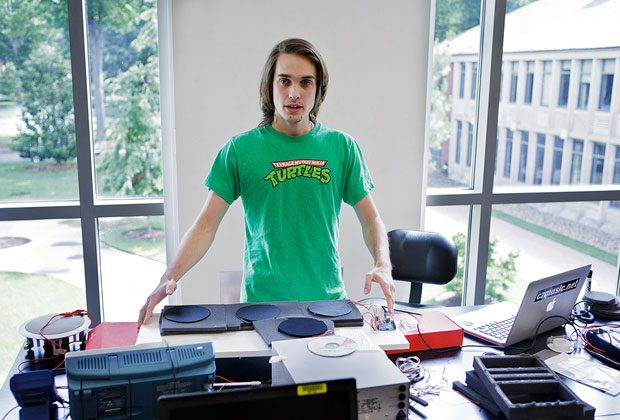Demo Day

In just three weeks, students in Professor John Conrad’s “Introduction to Embedded Systems” May Experience course learned how to connect sensors, actuators and indicators to create devices that interact with the physical world. Using the Arduino and Raspberry Pi open source microcontroller platforms, students developed and presented their own capstone independent design projects which they demoed and discussed Tuesday, May 28, in Rinker Hall.
Jonathan Alsip’s “Terrarium Climate Control” used a sensor to detect temperature and humidity in a terrarium and an Arduino to trigger devices such as a fogger, a rainfall system, a fan, and some heat lamps to simulate a basic natural environment.
Vincent Dowling’s “Arduino Video Game Console” utilized the Arduino Uno, an RCA cable, a Wii Nunchuck, wires, resistors, and an adapter for the Wii Nunchuck, to create a video console that can run very simple games if given the right code.
Dante Durrman’s “Autonomous Paintball Sentry” used a combination of sensors, motors, and other parts interfaced with Processing through Arduino to create an autonomous paintball sentry in which LEDs and sound effects abstract the process of firing a paintball gun.
Chase Fiedler’s “Scratchbuilt Ardupilot” used the Triple Axis Accelerometer & Gyro Breakout—MPU-6050 to send signals containing the board’s orientation to the Arduino. Once processed and translated, the microprocessor sent it to a servo position adjustment which then sent it to the appropriate servos that would stabilize the aircraft if it had air moving over the control surfaces.
Paul Gaglione created the “Wireless Whoopee Cushion” using two 2.4 Ghz X-bee adapters, a miniature speaker system, the Arduino computer via a breadboard and wires.
Using arduino boards and photo resistors, Joseph Kennedy created “The Welcoming Arduino—an LED welcoming board.”
Jason Kolleda created a working yet inexpensive “Archery Chronograph” using two separate switches, one when the arrow is fired to start the clock, and the second at the target triggered when the arrow strikes to end the clock.
Adam Moyer created the “Arduino Drum Kit,” an electronic midi drum kit, using Arduino. He used piezo sensors as pressure sensitive switches to trigger some midi drum sounds.
Learn more about Furman’s Physics program at http://www2.furman.edu/academics/physics/Pages/default.aspx.